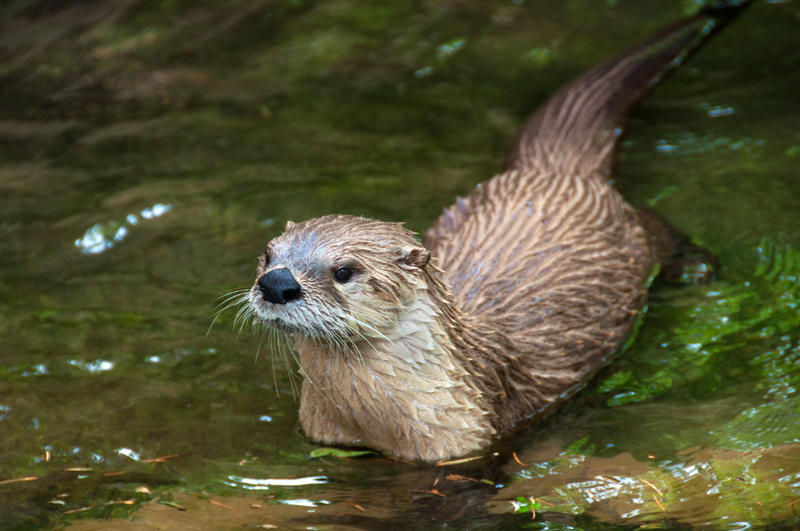
ID 24827404 © Camptoloma | Dreamstime.com
About
The Canada otter, Lutra canadensis, is also known as the “river otter”. It belongs to the Mustelidae family of musk carriers, which also includes the mink, marten, fisher, and skunk.
Distribution
The otter has never been very abundant in North America, but it is distributed throughout Canada and most of the United States. It is rare in Ontario’s agricultural south, and very common throughout the rest of Ontario.
Description
The otter has a streamlined body with a thick layer of fat beneath the skin. Adults measure between 90.2 and 129.5 cm (35.5 and 51 in) from nose to tail and are usually 25.4 cm (10 in) high at the shoulder. They weigh between 4.5 and 13.6 kg (10 and 30 lbs). The otter’s flat, round head is set on a wide neck, and features a short muzzle with large, sensitive whiskers and a flat, prominent nose. The protruding eyes provide excellent underwater vision. Other adaptations, which fit the otter for its semi-aquatic life-style, include short legs with large webbed feet, and muscles that close off the ears and nostrils when the otter is submerged. The claws do not retract, and the soles of the feet are hairy. The hind feet provide the main propulsion in the water. The muscular, flexible tail is thick at the base and tapers towards the tip. The otter’s coat is short, dense, rich and glossy. The upper parts are dark brown or black when wet, and the lower parts are paler. The lower jaw and the throat are white. The underfur is oily, soft and short, while the guard hairs are glistening, hard and long. Both sexes are alike in colouration, and immature otters resemble adults. There is no seasonal variation in the colouring. Moulting takes place in spring and fall.
Life History
Otters are sexually mature at the age of two years. They mate during March or April, shortly after the birth of the previous year’s young. Copulation takes place in the water and can last from 15 to 25 minutes. The gestation period is long – from nine and one-half months to just over a year. Thus, there can be only one litter per year, and the pups are usually born in March or April. Litters may contain from one to six pups; the average is two or three. The newborns are blind and toothless, and have black, silky coats. They are 20.3 cm (8 in) long and weigh between 124.4 and 156 g (4 and 5 oz). Their eyes open at 25 to 28 days and, at three months, the pups venture outside the den. They are weaned at four months, and the family remains together for about eight months or until a new litter is born. Wild otters may live from 10 to 20 years.
Habitat
Otters live close to water, and prefer lakes, marshes and streams. They never construct houses, but den in the abandoned lodges of beaver and in burrows in banks. Dry vegetation such as sticks, leaves and grass is used to line the dens.
Food and Feeding Behaviour
Otters feed mainly on fish, amphibians, crayfish and other invertebrates, turtles, snakes, waterfowl and muskrat. Their diet varies with the seasons, and some vegetation is eaten in summer. Otters hunt alone or, occasionally, in pairs. Unlike the beaver, otters do not cache food for later use.
Habits
Although otters are active mainly at night, they can sometimes be seen during the day. They do not hibernate. Intelligent, shy and docile, they are also quite social. They do not fight among themselves, except during the mating season, when males may tangle. They are very playful, enjoying a slide down a bank into the water. Accomplished swimmers, they can outdistance a trout in open water and can remain submerged for up to four minutes. On land, they range widely, travelling considerable distances up and down riverbanks. Otters maintain what are known as “pulling-out places” or toilets on banks. These are piles of debris, urine and excrement in which they roll around and rub themselves. As they roll, they tend to twist and mat the grass around the piles. Trappers should be on the lookout for these signs of otter activity. When alarmed, otters give off a musky odor.
Population Changes
The otter population appears to have remained stable since the 1950s. Since otters are associated with beaver ponds, their numbers increase in accordance with beaver numbers. Otters may contract tuberculosis, which is characterized by inflamed tissue in several organs and by respiratory problems. Control of this disease in wild animal populations is not practical. Guinea worms, which usually cause ulcers on the legs, are commonly found beneath the skin. They cannot be transferred to humans and do not damage the pelt. Giant kidney worm, another common parasite, is often found in the right kidney. If it spreads to both kidneys, the host dies. Ticks, roundworms and flukes also plague the otter.
Management
Since the 1950s, the otter harvest in Ontario has been comparatively stable. This suggests that the population can withstand current trapping pressures. In general, there has been no need for quotas. Trappers should consult regulations booklet to determine the dates of the otter season in their areas.

You must be logged in to post a comment.